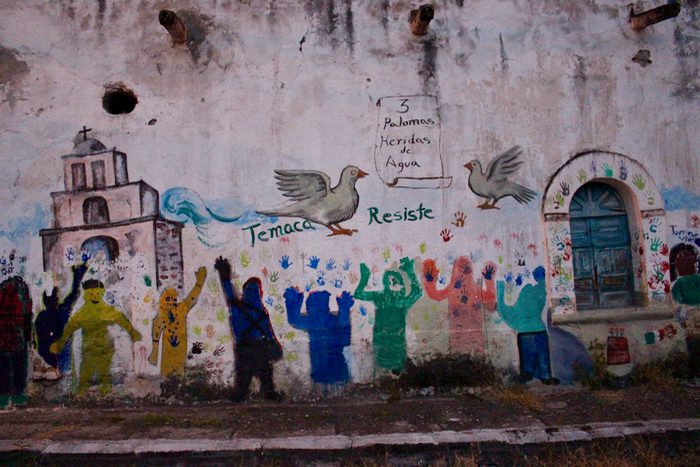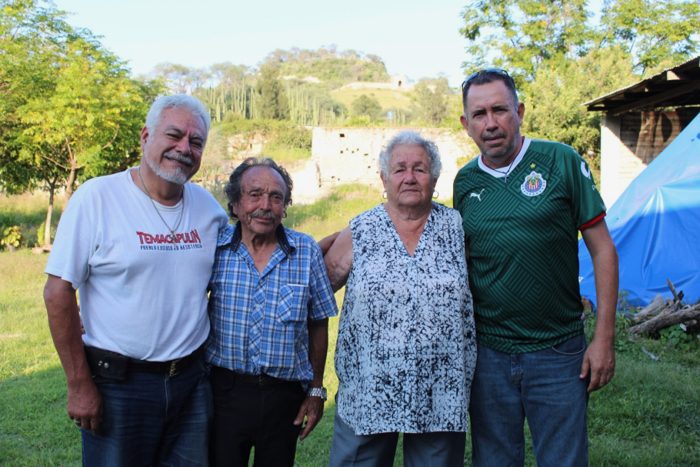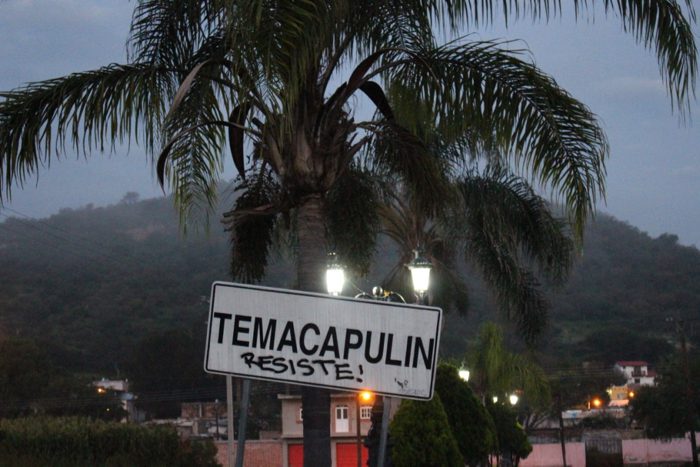By Tracy L. Barnett
For El Daily Post
Photo courtesy International Rivers
In the strange world of Mexican water politics, things got a bit stranger this week as a citizen’s coalition filed a formal complaint with the state auditor’s office regarding a $4.6 million hydrological study by the United Nations Office for Project Services (UNOPS) that critics say has already been done – another strike against the long-contested El Zapotillo dam.
What’s at stake: The town of Temacapulín, which has become an international tourist destination for its charming colonial architecture, its thermal waters and its authentic beauty; two tiny neighboring villages, Acasico and Palmarejo; nearly $1 billion (USD) of federal money; flooding of more than 4,500 hectares of highly productive farmland supplying more than 20 percent of national protein consumption; the longterm health of Lake Chapala; and, some say, the future water sovereignty of the state of Jalisco, a region already flagged by SEMARNAT, the Mexican Secretary of the Environment, for a future water crisis. A 2014 SEMARNAT report included Jalisco among the 15 Mexican states expected to see a 30% reduction in rainfall beginning in the next 15 years.

The complaint by members of the Regional Council for Sustainable Development, The Lerma-Lake Chapala-Santiago Watershed Foundation, the Jalisco Ranchers Forum and other groups – who say the state already commissioned a study similar to that of UNOPS to be done by the Mexican Institute for Water Technology for less than a tenth of that cost – comes in the wake of an announcement by Jalisco Secretary of Governance Roberto López Lara stating that the people of the picturesque colonial village of Temacapulín should begin evacuating now before the coming rainy season, when the lake will begin to fill.
López Lara’s comments, published in two local newspapers at the end of last week, sent a shockwave through the community. A Supreme Court ruling in 2013 – reaffirmed by a second ruling last year – had halted the construction on the dam at a height of 80 meters, which experts pegged as the maximum height to avoid flooding the town, with protective measures including two dikes which have not yet been built. This ruling, along with the pending UNOPS study, scheduled to be completed next year, had seemed to put the matter on hold for a while – especially since no plans for construction of the dikes have been presented. And, as critics are quick to point out, Gov. Aristoteles Sandoval has yet to disavow his promise to protect Temacapulín – announced in a tweet while on the campaign trail and reaffirmed as governor in a 2013 visit to the town.
A separate coalition of dam opponents led by the Committee to Save Temacapulín, Acasico and Palmarejo issued a communiqué on Wednesday blasting Lopez Lara, the governor and other officials for creating a “strategy of harassment” against the villagers in violation of the Supreme Court ruling with his comments that they should evacuate the area.

The 140-kilometer pipeline is planned to pipe an estimated 120 million cubic meters from the Rio Verde to a tributary of the Rio Lerma to serve the industrial city of Leon, Guanajuato – which critics say will deposit inadequately treated wastewater from its sizeable shoe industry along with municipal waste in Lake Chapala. It will also provide water to the city of Guadalajara and to the Los Altos region.
The Daily Post requested an interview with a representative of Lopez Lara or Gov. Sandoval, but the governor’s office routed queries to SEMADET, the state environmental agency. Asked whether there are plans to proceed with filling the dam this year, as indicated by Lopez, the e-mailed response appeared to negate that possibility, citing the two Supreme Court cases halting the construction at 80 feet. “This sentence is in effect until it is resolved in the final injunction filed by the victims against this work. Such action maintains the work completely suspended,” said the statement.
Asked why, in that case, Lopez Lara urged people to evacuate, the statement cited agreements made between the federal and state governments in 2005 and 2007 and executive decrees of 1995 and 1997 that declare the Rio Verde for urban domestic use. “This implies the necessity when the time comes for technical, economic and socially feasible actions to protect or relocate the populations that would be affected by the reservoir of the Zapotillo Dam.”
Last week, national media quoted Lopez Lara as saying about a hundred households in the three villages had already sold their properties to the government under an offer for financial compensation. SEMADET referred that question to Conagua, the federal agency charged with the dam project, and Conagua could not be reached for comment. Guadalupe Espinoza of the attorney’s collective opposing the dam was skeptical of that claim; the Committee to Save Temacapulín is keeping close watch on the situation and only knows of seven, he said. He has repeatedly requested that the government release this information and has not received an answer, he said.
The Committee to Save Temacapulín, the Collective of Attorneys and the Mexican Institute for Community Development (IMDEC), issued a strongly worded statement on Wednesday against the government’s “new strategy of harassment and violation of the security and physical and psychological integrity” of the residents.
Guadalupe Espinoza, one of the attorneys from the collective who helped draft the statement, said the comments of Lopez Lara appear to be a strategy to compel residents to leave their homes.
“The community is really nervous in the face of a possible eviction and flooding of their houses; it creates a lot of anxiety,” said Espinoza.

Among the points raised by the citizen collective:
* Besides the Supreme Court case, there are at least 10 legal actions (amparos) ongoing in the courts, said Espinoza, including several by residents of the villages that claim the dam is a violation of their rights.
* Miloon Kothari, the UN Special Rapporteur on the Right to Adequate Housing, and Olivier de Schutter, the UN Special Rapporteur on the Right to Food, have both visited the community and declared the proposed dam and the consequent flooding of the communities a violation of the residents’ human rights.
* Experts from the National Institute of Anthropology and History (INAH) and the Jalisco Secretary of Culture have determined that more than 70 percent of the homes in Temacapulin should be considered as historical heritage sites.
Irene Bonilla of IMDEC, one of the organizations that issued the communiqué, added another worry. Between 40 and 80 million people worldwide – 200,000 in Mexico alone –have been displaced by mega-dam projects like this one, she said, and numerous assassinations of activists, such as the recent murder of Bertha Cáceres in Honduras, have resulted. Impacts of these projects on the environment are severe, affecting fisheries and wildlife of the entire watershed. What’s worse, they generate large amounts of methane, one of the worst greenhouse gases.
“We are paying for a lot water we wouldn’t need if our system was working correctly,” she said.
University of Guadalajara researcher Arturo Gleason has said that the Guadalajara Metropolitan Area currently wastes enough water to fill a couple of Zapatillo dams – through loss of rainwater runoff – which amounts to more than 300 million cubic meters per year, three times the amount that the dam would store – and through its leaky distribution system, which he estimates is losing more than 100 million cubic meters, or between 30 and 40 percent of the city’s water supply, through leaky pipes and pumps alone.
To add insult to injury, says Gleason, dams like these have a lifespan of 30 years maximum due to the sedimentation that builds up. By the end of these 30 years we have no idea what will be left of local water resources, he argues, as there is no system in place to measure the rapidly depleting aquifers or the amount of rainwater flowing back in to recharge them – so the assumption that Jalisco has an excess of water to share with Leon is faulty from the outset.
“The information about the availability of water in the watershed is out of date,” he said. “We don’t know how much water there is, and there is no mechanism for measuring it.” They are shipping water to Leon based on a study from 1997, and a lot has changed since then.”
Together with the Citizens Observatory for Integral Water Management, he has proposed a plan that would create a system of rainwater capture and of badly needed city parks, which would provide recharge areas channeling the city’s prolific runoff during rainy season back into the depleted aquifers.
Back in Temaca, where citizens have withstood a decade-long roller-coaster in the fight to save their village, people on alert, ready for whatever comes, said Padre Gabriel Espinoza, a Catholic priest-turned-activist, farmer and spokesman for the Committee to Save Temaca.
“If Roberto López Lara has something to say to us, we’d like for him to tell us here in Temacapulín, just like he did back in 2013 when he came with the governor and promised us to protect our village,” said Espinoza. Before taking office, Sandoval had sent out a tweet saying he would protect Temacapulin, and he followed up three months later with a visit in person, when he promised a series of mesas de trabajo (work meetings), advocating on behalf of the villages and the environment. Lopez Lara did follow through on a series of meetings, but nothing was resolved, Espinoza said.

The fight to save Temaca has had at least one benefit: The number of tourists has increased around 500 percent, estimates Padre Espinoza. Temaca has always been a tourism destination, he says, but he has no doubt that the recent boom has been inspired by the international attention the town has received. “They come from everywhere – the United States, Canada, Europe.”
“Threats also bring benefits,” he reflected. “You have to bring out the positive from the negative.”
Tracy L. Barnett is a freelance writer based in Guadalajara.

Dams El Zapotillo environment hydroelectric Jalisco Los Altos de Jalisco Mexico Temacapulin water